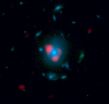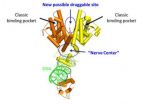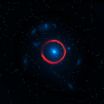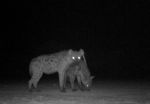(Press-News.org) Astronomers using the Atacama Large Millimeter/submillimeter Array (ALMA) telescope have discovered starburst galaxies earlier in the Universe's history than they were previously thought to have existed. These newly discovered galaxies represent what today's most massive galaxies looked like in their energetic, star-forming youth. The research is the most recent example of the discoveries coming from the new international ALMA observatory, which celebrates its inauguration today.
The results, published in a set of papers to appear in the journal Nature and in the Astrophysical Journal, will help astronomers better understand when and how the earliest massive galaxies formed.
The most intense bursts of star birth are thought to have occurred in the early Universe in massive, bright galaxies. These starburst galaxies converted vast reservoirs of gas and dust into new stars at a furious pace - many thousands of times faster than stately spiral galaxies like our own Milky Way.
The international team of researchers first discovered these distant starburst galaxies with the National Science Foundation's 10-meter South Pole Telescope. Though dim in visible light, they were glowing brightly in millimeter wavelength light, a portion of the electromagnetic spectrum that the new ALMA telescope was designed to explore.
Using only 16 of ALMA's eventual full complement of 66 antennas, the researchers were able to precisely determine the distance to 18 of these galaxies, revealing that they were among the most distant starburst galaxies ever detected, seen when the Universe was only one to three billion years old. These results were surprising because very few similar galaxies had previously been discovered at similar distances, and it wasn't clear how galaxies that early in the history of the Universe could produce stars at such a prodigious rate.
"The more distant the galaxy, the further back in time one is looking, so by measuring their distances we can piece together a timeline of how vigorously the Universe was making new stars at different stages of its 13.7 billion-year history," said Joaquin Vieira a postdoctoral scholar at Caltech who led the team and is lead author of the Nature paper.
In fact, two of these galaxies are the most distant starburst galaxies published to date - so distant that their light began its journey when the Universe was only one billion years old. Intriguingly, emission from water molecules was detected in one of these record-breakers, making it the most distant detection of water in the Universe published to date.
"ALMA's sensitivity and wide wavelength range mean we could make our measurements in just a few minutes per galaxy - about one hundred times faster than before," said Axel Weiss of the Max-Planck-Institute for Radioastronomy in Bonn, Germany, who led the work to measure the distances to the galaxies. "Previously, a measurement like this would be a laborious process of combining data from both visible-light and radio telescopes."
The galaxies found in this study have relatives in the local Universe, but the intensity of star formation in these distant objects is unlike anything seen nearby. "Our most extreme galactic neighbors are not forming stars nearly as energetically as the galaxies we observed with ALMA," said Vieira. "These are monstrous bursts of star formation."
The new results indicate these galaxies are forming 1,000 stars per year, compared to just 1 per year for our Milky Way galaxy.
This unprecedented measurement was made possible by gravitational lensing, in which the light from a distant galaxy is distorted and magnified by the gravitational force of a nearer foreground galaxy. "These beautiful pictures from ALMA show the background galaxies warped into arcs of light known as Einstein rings, which encircle the foreground galaxies," said Yashar Hezaveh of McGill University in Montreal, Canada, who led the study of the gravitational lensing. "The dark matter surrounding galaxies half-way across the Universe effectively provides us with cosmic telescopes that make the very distant galaxies appear bigger and brighter."
Analysis of this gravitational distortion reveals that some of the distant star-forming galaxies are as bright as 40 trillion Suns, and that gravitational lensing has magnified this light by up to 22 times. Future observations with ALMA using gravitational lensing can take a more detailed look at the distribution of dark matter surrounding galaxies.
"This is an amazing example of astronomers from around the world collaborating to make an exciting discovery with this new facility," said Daniel Marrone with the University of Arizona, principal investigator of the ALMA gravitational lensing study. "This is just the beginning for ALMA and for the study of these starburst galaxies. Our next step is to study these objects in greater detail and figure out exactly how and why they are forming stars at such prodigious rates."
###
ALMA, an international astronomy facility, is a partnership of Europe, North America and East Asia in cooperation with the Republic of Chile.
ALMA construction and operations are led on behalf of Europe by ESO, on behalf of North America by the National Radio Astronomy Observatory (NRAO), and on behalf of East Asia by the National Astronomical Observatory of Japan (NAOJ). The Joint ALMA Observatory (JAO) provides the unified leadership and management of the construction, commissioning and operation of ALMA.
The National Radio Astronomy Observatory is a facility of the National Science Foundation, operated under cooperative agreement by Associated Universities, Inc.
The incidence of genital warts, or condylomata, declined by 93 per cent in girls given the HPV vaccine before the age of 14, according to a Swedish national registry study. The study was carried out by researchers at Karolinska Institutet in Sweden, and published in Journal of the National Cancer Institute.
Using a selection of population-based registries, the researchers at Karolinska Institutet studied 124,000 girls and women in Sweden between 10 and 44 years old who had received the HPV vaccine against condyloma and cervical cancer at some time between 2006 and 2010. ...
Results from the Fluid Expansion as Supportive Therapy (FEAST) trial in East Africa show that children who are given fluid to treat shock have an increased risk of death due to cardiovascular collapse at 48 hours. These findings in BioMed Central's open access journal BMC Medicine challenge the generally held idea that early and rapid reversal of shock by fluid resuscitation translates into longer-term survival benefits.
The FEAST trial was conducted in six African hospitals across Kenya, Tanzania and Uganda without intensive care facilities. It included 3000 children ...
For the first time, researchers have mapped the genomes of tapeworms to reveal potential drug targets on which existing drugs could act. The genomes provide a new resource that offers faster ways to develop urgently needed and effective treatments for these debilitating diseases.
Tapeworms cause two of the World Health Organization's 17 neglected tropical diseases; echinococcosis and cysticercosis. The team sequenced the genomes of four species of tapeworm to explore the genetics and underlying biology of this unusual parasite. As an adult it can live relatively harmlessly ...
Results of a study published online in the Journal of Antimicrobial Chemotherapy today (Thursday), demonstrate that computer models can predict how HIV patients whose drug therapy is failing will respond to a new treatment. Crucially for patients in poorer countries, the models do not require the results of expensive drug resistance tests to make their predictions. The study also showed that the models were able to identify alternative drug combinations that were predicted to work in cases where the treatment used in the clinic had failed, suggesting that their use could ...
Autism results from abnormal cell communication. Testing a new theory, researchers at the University of California, San Diego School of Medicine have used a newly discovered function of an old drug to restore cell communications in a mouse model of autism, reversing symptoms of the devastating disorder.
The findings are published in the March 13, 2013 issue of the journal PLOS ONE.
"Our (cell danger) theory suggests that autism happens because cells get stuck in a defensive metabolic mode and fail to talk to each other normally, which can interfere with brain development ...
Some of the brightest galaxies in the universe – infant galaxies that churned out tens of thousands of stars each year at the dawn of the universe – evolved much sooner and in greater numbers than previously thought, according to new measurements obtained by University of Arizona astronomers.
The results are published in a set of papers to appear in the journal Nature on March 14 and in the Astrophysical Journal. The research is the most recent example of the discoveries coming from the new international ALMA observatory, which celebrates its inauguration today. ALMA, ...
ORLANDO, Fla., March 13, 2013 – Researchers at Sanford-Burnham Medical Research Institute (Sanford-Burnham) have determined the complete three-dimensional structure of a protein called HNF-4α. HNF-4α controls gene expression in the liver and pancreas, switching genes on or off as needed. People with mature onset diabetes of the young (MODY1), a rare form of the disease, have inherited mutations in the HNF-4α protein. This first-ever look at HNF-4α's full structure, published March 13 in Nature, uncovers new information about how it functions. The study ...
NEW YORK, MARCH 13, 2013 – Researchers have discovered a unique monoclonal antibody that can effectively reach inside a cancer cell, a key goal for these important anticancer agents, since most proteins that cause cancer or are associated with cancer are buried inside cancer cells. Scientists from Memorial Sloan-Kettering Cancer Center and Eureka Therapeutics have collaborated to create the new human monoclonal antibody, which targets a protein associated with many types of cancer and is of great interest to cancer researchers.
Unlike other human therapeutic monoclonal ...
When a batch of bright cosmic objects first appeared in maps in 2008 made with data from the South Pole Telescope, astronomers at the University of Chicago's Kavli Institute for Cosmological Physics regarded it only as an unavoidable nuisance.
The light sources interfered with efforts to measure more precisely the cosmic microwave background—the afterglow of the big bang. But the astronomers soon realized that they had made a rare find in South Pole Telescope's large survey of the sky. The spectra of some of the bright objects, which is the rainbow of light they emit, ...
In the southern Rift Valley of Kenya, the Maasai people, their livestock and a range of carnivores, including striped hyenas, spotted hyenas, lions and bat-eared foxes, are coexisting fairly happily according to a team of coupled human and natural systems researchers.
"I wouldn't call the results surprising," said Meredith Evans Wagner, a visiting scholar from the University of Florida in the Center for Systems Integration and Sustainability (CSIS) at Michigan State University and part of the research team. "Other research has shown that people and carnivores can coexist, ...



